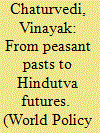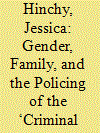|
|
|
Sort Order |
|
|
|
Items / Page
|
|
|
|
|
|
|
| Srl | Item |
| 1 |
ID:
108994


|
|
|
|
|
| Publication |
2011.
|
| Summary/Abstract |
This paper considers the participation and initiation of communities once classified as criminal tribes in the violence in Gujarat in 2002. Given that their descendants continue to suffer politically and economically in post-colonial India, it is necessary to examine the role of the marginalised and subordinate communities in the making of Hindutva in the twenty-first century. Building upon debates on violence in post-colonial societies, the paper examines the historical contexts for why victims often become killers in genocide. More specifically, it provides an analysis of one specific community of poor, low-caste peasants, the Dharalas, who participated in the violence against Muslims in Gujarat. The paper also examines the limits of historical methodology for the writing of histories of violence from 'below'.
|
|
|
|
|
|
|
|
|
|
|
|
|
|
|
|
| 2 |
ID:
174137


|
|
|
|
|
| Summary/Abstract |
In the South Asian setting, the fields of gender history and family history are still predominantly concerned with relatively elite social groups. Few studies have examined issues of gender and the family in the history of Dalit, low-caste, and socially marginalized communities, especially those that were labelled ‘criminal tribes’ from the mid-nineteenth century on. This article explores the ways in which gender patterned criminalized communities’ experiences of everyday colonial governance under Part I of the 1871 Criminal Tribes Act (CTA) in the first two decades that it was enforced in northern India. In this early period, the colonial government did not closely regulate marriage practices, domestic arrangements, or the gendered organization of labour within communities categorized as ‘criminal tribes’. Nevertheless, notions of sexuality and gender underlay colonial knowledge of the ‘criminal tribes’, which emerged in dialogue with middle-class Indian gender and caste politics. Moreover, the family unit was the central target of the CTA surveillance and policing regime, which aimed to produce ‘industrious’ families. Officially endorsed forms of labour had complex implications for criminalized communities in the context of North Indian gender norms and strategies of social mobility. Gender power dynamics also shaped criminalized peoples’ interpersonal, embodied interactions with British and Indian colonial officials on an everyday basis. Meanwhile, different forms of leverage and evasion were open to men and women to cope with their criminalization and so the colonial state was experienced in highly gendered ways.
|
|
|
|
|
|
|
|
|
|
|
|
|
|
|
|
| 3 |
ID:
121954


|
|
|
|
|
| Publication |
2013.
|
| Summary/Abstract |
This paper contributes to the history of 'criminal tribes', policing and governance in British India. It focuses on one colonial experiment-the policing of Moghias, declared by British authorities to be 'robbers by hereditary profession'-which was the immediate precursor of the first Criminal Tribes Act of 1871, but which so far altogether has passed under historians' radar. I argue that at stake in the Moghia operations, as in most other colonial 'criminal tribe' initiatives, was neither the control of crime (as colonial officials claimed) nor the management of India's itinerant groups (as most historians argue), but the uprooting of the indigenous policing system. British presence on the subcontinent was punctuated with periodic panics over 'extraordinary crime', through which colonial authorities advanced their policing practices and propagated their way of governance. The leading crusader against this 'crisis' was the Thuggee and Dacoity Department, which was as instrumental in the 'discovery' of the 'Moghia menace' and 'criminal tribes' in the late nineteenth century as in the earlier suppression of the 'cult of Thuggee'. As a policing initiative, the Moghia campaign failed consistently for more than two decades. Its failures, however, reveal that behind the façade-anxieties over 'criminal castes' and 'crises of crime' stood attempts at a systemic change of indigenous governance. The diplomatic slippages of the campaign also expose the fact that the indigenous rule by patronage persisted-and that the consolidation of the colonial state was far from complete-well into the late nineteenth century.
|
|
|
|
|
|
|
|
|
|
|
|
|
|
|
|
| 4 |
ID:
129012


|
|
|
|
|
|
|
|